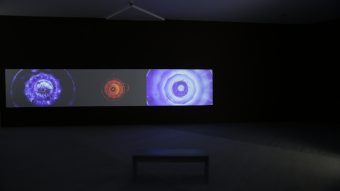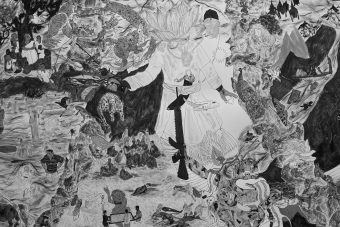When we visited the Shilpakala Academy the night before the opening of the Dhaka Art Summit, we were overwhelmed by the vibrant chaos of activity we saw in the venue – though not in the way we’d expected. Half-expecting to see glimpses of a near-complete exhibition space, with perhaps a few installers here and there making minute final adjustments, we instead arrived to a scene of a few hundred mostly-Bangladeshi labourers in sandals and lunghis installing artworks and working from bamboo scaffolds building entire structures from scratch. Between work, the men squatted outside the building smoking cigarettes, chatting and laughing amongst themselves. Joined by a delegation of artists, curators and writers supported by the Australia Council for the Arts, I was attending the summit to engage in creative exchanges and conversations with artists and collectives from across South and South East Asia.
It was hard to imagine how an art summit of this scale—which was to open in less than 15 hours—could be completed overnight. And yet when we arrived the next morning for the opening, there it was. It was starkly plain to us that such a feat had been made possible because of those few hundred labourers working through the night into the early hours.
But I shouldn’t have been so surprised. I’d transited through Singapore just a week earlier. Singapore, a country which first blush is the image of a glamorous and cosmopolitan city-state, reveals a deeper, more complicated layer upon the second glance. When I look to the reclaimed land of Marina Bay and the gleaming glass and steel environment of Downtown Financial Precinct, I am reminded that Singapore is a country built on migrant flows and cheap labour. Male Bangladeshi workers are trucked into the city from Changi airport, sitting six by two, driving on roads likely built by the labourers who came just before them. Such labour flows are similarly seen in Dhaka, one of the world’s most densely populated cities, in a new country, which is still experiencing many growing pains.
How can we make sense of such complex historical, material, political and social flows? In what ways can art make strange or decentralise straightforward narratives of the world to account for our entangled pasts, presents and futures?
These are the questions that underpin Seismic Movements: Dhaka Art Summit 2020 (DAS 2020). The summit, which seeks to highlight the power of thinking and organising collectively, covers a spectrum of movements concerning the Global South. Both historical in outlook and oriented towards future possibilities, DAS 2020 spans “geological movements, colonial movements, social movements, spatial movements and feminist futures”. Here, the notion of a ‘seismic’ movement has both ecological and socio-political connotations. It speaks on the one hand to the growing environmental and socio-political concerns pertaining to the region, which is already experiencing first-hand some of the most extreme effects of climate devastation. And, at the same time, hints at the possibilities of an organised collective rupturing dominant social and political systems, and ways of being in the world. In calling greater attention to the points of connection between movements, the summit offered a way forward, foregrounding new ways of being, knowing and doing.

Liu Chuang’s Bitcoin Mining and Field Recordings of Ethnic Minorities (2018) is one such example that seeks to emphasise invisible social relations and flows between movements. This work explores how hydroelectric power in the remote mountainous regions of China partially fuels the cryptocurrency mining industry. In the three-channel video installation, we are transported across river systems and cascading hydroelectric reservoirs, through mountains dotted with cellular base stations, and into nostalgic, neon-lit karaoke booths. These regions form part of the ‘Zomia’, which refers to a highland mountainous region in Asia. In the Zomia region, Indigenous communities and ethnic minorities have evaded and resisted central powers for more than two thousand years, largely due in part to how difficult it is to reach the steep upland terrain.[1] According to political scientist James C. Scott, those dwelling in the Zomia were able to trade and negotiate with the central state authorities whilst maintaining their autonomy. In Bitcoin Mining and Field Recordings of Ethnic Minorities, Chuang draws an intriguing parallel between bitcoin and the Zomia region. Like those dwelling in the Zomia, bitcoin is similarly borne from an urge to remain decentralised from central national control. However, Chuang argues that both bitcoin and the comparatively independent power of the Zomia are ultimately dependent upon the infrastructure of their respective central powers.
Similarly, Karan Shrestha’s intricate ink-based work forming part of in these folds (2019) speaks to the complex, entangled relations between people, time, and space, probing at the fraught rhetoric of progress in relation to Nepal’s recent history. Shrestha presents a work that is both an archive of physical landscapes, political histories, and transient memories, and a speculative world that suspends reality, creating space to think through notions of the present. In this labyrinth of overwhelming visual assemblages, a beaked god-like figure is adorned in camouflage print, sneakers and elaborate jewellery. In its hands are a grenade, and a vessel filled with petals. Two tourists peer into binoculars towards a five-headed dog amongst carcasses lying in the distance; a rhinoceros perches uncertainly on a mountain range; lizards, cicadas and beetles scuttle amongst AK-47s and bulldozers. Somewhere I see a figure in a checkered suit cycling through a riot squad. in these folds is an examination of the absolute precariousness of modernity, and the narratives of progress that are held to be true.

Looking beyond art as artefact, collective artistic practices at DAS 2020 embodied the possibilities of alternative ways of knowing, being and doing. Bangladeshi record label and artist collective Akaliko presented Ogadha’ Ekkattata – a deeply moving live music experimental work—which invited audiences to consider the histories of collective practice in Bangladesh, via multiple sonic fragments referencing political and social movements.
In Gidree Bawlee’s Golpota Shobar, children performed stories surrounding natural and supernatural incidents occurring in their village in northwest Bangladesh. Their costumes, comprised of found materials, depicted non-human beings imagined through a combination of oral stories conveyed to them from their elders, as well as extinct and endangered species, spirits, and speculative mythical creatures. In this work, the costume becomes a process of reincarnation of these beings and stories. Dancing and forming a procession around Taloi Havini’s immense structure Reclamation (2020), their performance told narratives of climate change, Indigenous forms of knowledge transmission, and the importance of storytelling.
Speculative Collective, an activation by Jakarta-based collective Gudskul, invited participants to form a space of encounter wherein we were encouraged to share knowledge and exchange ideas with other participants. This incited conversation with strangers spanning ecological, social, and political interests and concerns such as climate change, pickling subcultures, and matsutake (a highly sought-after mushroom that is notoriously hard to find, examined in Anna Lowenhaupt Tsing’s Mushroom at the End of the World)[2]. These discussions became the basis for forging temporary micro-collectives, encouraging us to consider alternative ways of learning and knowledge exchange as we sought to envision different futures and possibilities through collective making.
While the summit’s curatorial premise aimed to draw common threads between social, ecological, cultural, and political movements, it ultimately presented these movements as having cleanly-marked boundaries, spatially organising the movements according to distinct galleries and floors. For instance, where might we draw the line between a colonial movement and an environmental movement, or feminist futures and geological ones? And how can we make sense of the relationship between the labour behind and the consumption of art?
I return to the question I posed earlier: what modes and representational methods can allow for deep considerations of these complex flows? I don’t have a certain answer to this question except to say, for me, where there are collective formations there is power and hope for the possibilities of the future(s) to come. Singing karaoke alongside Gudskul, with a semi-functioning microphone and a projector screening YouTube videos on the concrete rooftop of Shilpakala at 10pm – this is where that hope felt most palpable.
[1] Scott, J.C., 2010. The art of not being governed: An anarchist history of upland Southeast Asia. Nus Press.
[2] Tsing, A.L., 2015. The mushroom at the end of the world: On the possibility of life in capitalist ruins. Princeton University Press.

